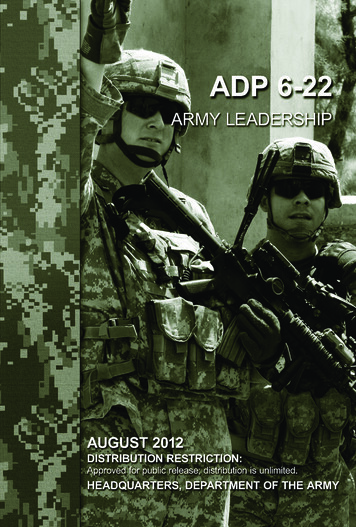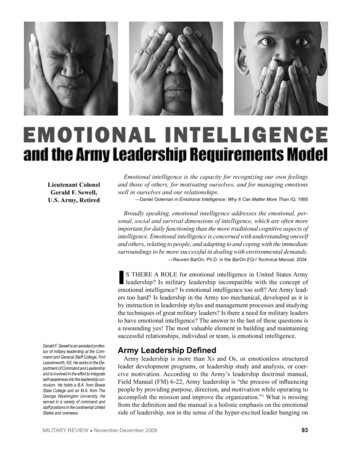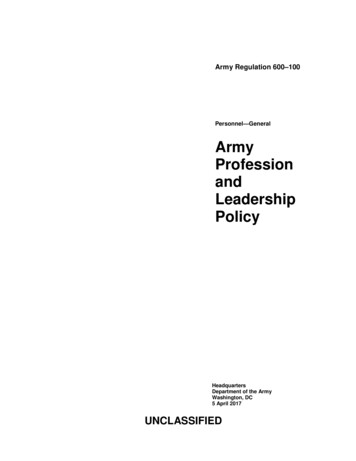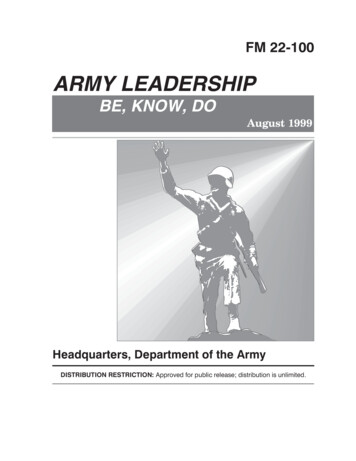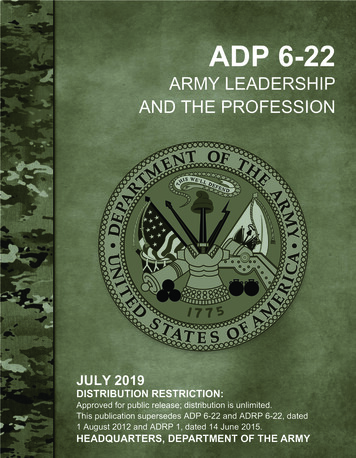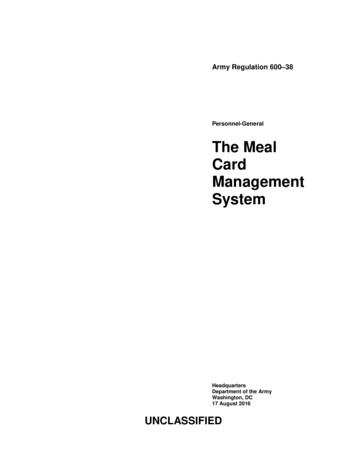
Transcription
The University of AkronArmy ROTCThe 42nd Ohio Volunteer BattalionSpring Semester, 2014Introduction to Army LeadershipPart 1 of 3
The University of AkronArmy ROTCThe 42nd Ohio Volunteer BattalionSpring Semester, 2014Introduction to Army LeadershipPart 1 Overview Definitions Levels of LDRS ADP 6-22 BE-KNOW-DO ALRM CC LDPPart 2 CC LDP Attributes Character Presence IntellectPart 3 CC LDP Competencies Lead Develop Achieve
The University of AkronArmy ROTCThe 42nd Ohio Volunteer BattalionSpring Semester, 2014In YOUR words, what is LEADERSHIP? ? ?
The University of AkronArmy ROTCThe 42nd Ohio Volunteer BattalionSpring Semester, 2014
The University of AkronArmy ROTCThe 42nd Ohio Volunteer BattalionSpring Semester, 2014Class Objectives Define Leadership according to Army Doctrine Publication(ADP) 6-22, Army Leadership Identify the three levels of Army Leadership: direct,organizational, and strategic Understand the Army Leadership Requirements Model Identify “Be, Know, and Do” as the pillars of the ArmyLeadership Requirements Model Define “Be, Know, and Do” within the context of ArmyLeadership Doctrine Relate “Be, Know, and Do” to the Cadet CommandLeadership Development Program
The University of AkronArmy ROTCThe 42nd Ohio Volunteer BattalionSpring Semester, 2014Leadership – What is it?“Leadership is the process of influencing people byproviding purpose, direction, and motivation toaccomplish the mission and improving theorganization.”An Army leader is anyone who by virtue ofassumed role or assigned responsibility inspires andinfluences people to accomplish organizationalgoals. Army leaders motivate people both inside andoutside the chain of command to pursue actions,focus thinking, and shape decisions for the greatergood of the organization.
The University of AkronArmy ROTCThe 42nd Ohio Volunteer BattalionSpring Semester, 2014
The University of AkronArmy ROTC3 Levels of Army Leadership StrategicStrategic leaders include military andArmy civilian leaders at the majorcommand through Department ofDefense (DOD) levels. OrganizationalOrganizational leaders lead andinfluence several hundred to severalthousand people. They usually do thisthrough several levels of leaders andsubordinates and are assisted by staffs. DirectFace to face, first line leadership.Takes place in organizations wheresubordinates are used to seeingtheir leaders all the time.The 42nd Ohio Volunteer BattalionSpring Semester, 2014LEVELSOFARMYLEADERSHIP
The University of AkronArmy ROTC3 Levels of Army Leadership StrategicStrategic leaders include military andArmy civilian leaders at the majorcommand through Department ofDefense (DOD) levels. OrganizationalOrganizational leaders lead andinfluence several hundred to severalthousand people. They usually do thisthrough several levels of leaders andsubordinates and are assisted by staffs. DirectFace to face, first line leadership.Takes place in organizations wheresubordinates are used to seeingtheir leaders all the time.The 42nd Ohio Volunteer BattalionSpring Semester, 2014LEVELSOFARMYLEADERSHIP
The University of AkronArmy ROTC3 Levels of Army Leadership StrategicStrategic leaders include military andArmy civilian leaders at the majorTRADOC and Cadetcommand through Department ofCommandLeadershipDefense(DOD) levels. OrganizationalOrganizational leaders lead andinfluence several hundred to severalBrigade and Battalionthousand people. They usually do thisLeadershipthroughCadreseverallevels of leaders andsubordinates and are assisted by staffs. DirectFace to face, first line leadership.TakesMSplacein organizationsInstructor& Cadet wheresubordinates are used to seeingLeadershiptheir leadersall the time.The 42nd Ohio Volunteer BattalionSpring Semester, 2014LEVELSOFARMYLEADERSHIP
The University of AkronArmy ROTCThe 42nd Ohio Volunteer BattalionSpring Semester, 2014The Basis of Leadership1. All Army team members, Soldiers and civilians, must have a basis ofunderstanding for what leadership is and does – which is deeply-rooted invalues, the Warrior Ethos, and professional competence.2. National and Army values influence the leader’s character andprofessional development, instilling a desire to acquire the essentialknowledge to lead. Leaders apply this knowledge within a spectrum ofestablished competencies to achieve successful mission accomplishment.3. The roles and functions of Army leaders apply to the three interconnectedlevels of leadership: direct, organizational, and strategic. Within theselevels of leadership, cohesive teams can achieve collective excellencewhen leadership levels interact effectively.
The University of AkronArmy ROTCThe 42nd Ohio Volunteer BattalionSpring Semester, 2014The Be, Know, DoLeadership PhilosophyThe Army uses the shorthand expression of BE-KNOW-DO toconcentrate on key factors of leadership. What leaders DO emerges fromwho they are (BE) and what they KNOW. Leaders are prepared throughouttheir lifetimes with respect to BE-KNOW-DO so they will be able to act at amoment’s notice and provide leadership for whatever challenge they mayface.ADP 6-22 describes the character attributes and core competencies requiredof contemporary leaders. Character is based on the attributes central to a leader’s make-up. Competence comes from how character combines with knowledge,skills, and behaviors to result in leadership.
The University of AkronArmy ROTCThe 42nd Ohio Volunteer BattalionSpring Semester, 2014The Be, Know, DoLeadership PhilosophyBE: Who You Are --- A Leader of Character and a Leader of Presence.Character defines who you are as a leader. It is how you demonstrate your values. Who youare is not something you can turn on and off. It is 24 hours per day and 7 days a week onand off duty, regardless of who might be watching.KNOW: Skills You Have Mastered --- A Leader With IntellectualCapacity.Competence in your field --- This is accomplished by gaining knowledge and masteringappropriate skills. This takes self-motivation. You have to WANT to learn.DO: How You Carry out Your Decisions --- Leads, Develops, andAchieves.A Leader’s actions are observable and will be how he/she is ultimately evaluated and willdetermine his/her effectiveness as a leader. Leadership takes place in action. What youDO is every bit as important as the BE and KNOW aspects of the Army LeadershipPhilosophy.
The University of AkronArmy ROTCThe 42nd Ohio Volunteer BattalionSpring Semester, 2014ADP 6-22ALRM conveys the expectations that the Army wants leaders to meet.
The University of AkronArmy ROTCThe 42nd Ohio Volunteer BattalionSpring Semester, 2014Cadet CommandLeadershipDevelopmentProgram
The University of AkronArmy ROTCThe 42nd Ohio Volunteer BattalionSpring Semester, 2014Blue Card (Front)
The University of AkronArmy ROTCThe 42nd Ohio Volunteer BattalionSpring Semester, 2014Blue Card (Front)BE
The University of AkronArmy ROTCThe 42nd Ohio Volunteer BattalionSpring Semester, 2014Blue Card (Front)KNOW
The University of AkronArmy ROTCThe 42nd Ohio Volunteer BattalionSpring Semester, 2014Blue Card (Front)DO
The University of AkronArmy ROTCThe 42nd Ohio Volunteer BattalionSpring Semester, 2014Blue Card (Reverse)
The University of AkronArmy ROTCThe 42nd Ohio Volunteer BattalionSpring Semester, 2014Practical Exercise Pair up with a battle-buddy. Look at the front side of a LeadershipAssessment Report (Blue Card). With respect to BE, KNOW, DO, review thecharacter attributes and core competenciesand decide 2-3 specific areas that you and yourbattle-buddy want to improve this semesterand why. Be prepared to share your findings with theclass.
The University of AkronArmy ROTCThe 42nd Ohio Volunteer BattalionSpring Semester, 2014A Final ThoughtIt takes personal courage to take theinitiative to make something happenrather than standing by or withdrawingand hoping events will turn out well.
The University of AkronArmy ROTCThe 42nd Ohio Volunteer BattalionSpring Semester, 2014Next ClassPart 1 Overview Definitions Levels of LDRS ADP 6-22 BE-KNOW-DO ALRM CC LDPPart 2 CC LDP Attributes Character Presence IntellectPart 3 CC LDP Competencies Lead Develop Achieve
The University of AkronArmy ROTCThe 42nd Ohio Volunteer BattalionSpring Semester, 2014Be Safe. Be Smart. Be Legal.Stay Focused on YOUR Goals.Are YOU committed?Are YOU ALLIN?
3 Levels of Army Leadership L E V L S O F A R M Y L E A D R S H I P MS Instructor & Cadet Leadership Brigade and Battalion Cadre Leadership TRADOC and Cadet Command Leadership . The University of Akron Army ROTC The 42nd Ohio Volunteer Battalion Spring Semester, 2014 The Basis of Leadership 1. All Army team members, Soldiers and civilians, must .
